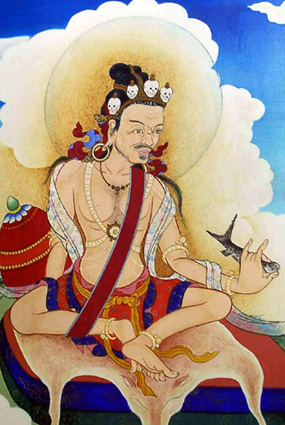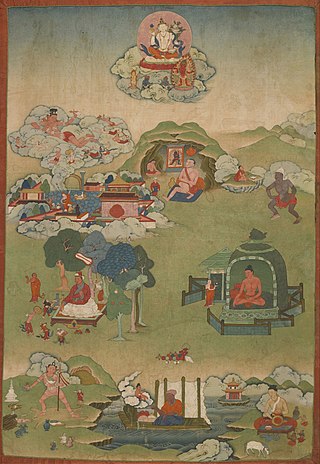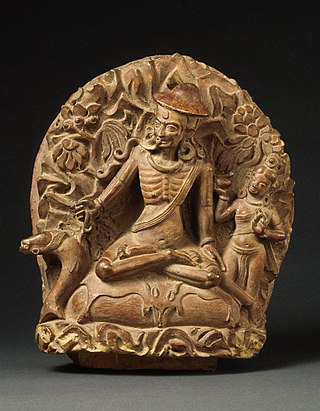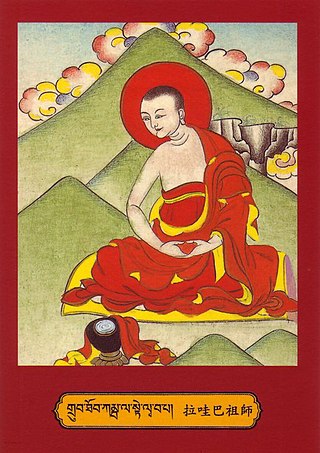
Tibetan Buddhism is a form of Buddhism practiced in Tibet, Bhutan and Mongolia. It also has a sizable number of adherents in the areas surrounding the Himalayas, including the Indian regions of Ladakh, Darjeeling, Sikkim, and Zangnan, as well as in Nepal. Smaller groups of practitioners can be found in Central Asia, some regions of China such as Northeast China, Xinjiang, Inner Mongolia and some regions of Russia, such as Tuva, Buryatia, and Kalmykia.

Vajrayāna, also known as Mantrayāna, Mantranāya, Guhyamantrayāna, Tantrayāna, Tantric Buddhism, and Esoteric Buddhism, is a Buddhist tradition of tantric practice that developed in Medieval India and spread to Tibet, Nepal, other Himalayan states, East Asia, parts of Southeast Asia and Mongolia.

Mahāmudrā literally means "great seal" or "great imprint" and refers to the fact that "all phenomena inevitably are stamped by the fact of wisdom and emptiness inseparable". Mahāmudrā is a multivalent term of great importance in later Indian Buddhism and Tibetan Buddhism which "also occurs occasionally in Hindu and East Asian Buddhist esotericism."

Tilopa was an Indian Buddhist tantric mahasiddha who lived along the Ganges River. He practised Anuttarayoga Tantra, a set of spiritual practices intended to accelerate the process of attaining Buddhahood. He became a holder of all the tantric lineages, possibly the only person in his day to do so. In addition to the way of insight and Mahamudra, Tilopa learned and passed on the Way of Methods and guru yoga. Naropa is considered his main student.

Sahaja means spontaneous enlightenment in Indian and Tibetan Buddhist spirituality. Sahaja practices first arose in Bengal during the 8th century among yogis called Sahajiya siddhas.

Nāropā was an Indian Buddhist Mahasiddha. He was the disciple of Tilopa and brother, or some sources say partner and pupil, of Niguma. As an Indian Mahasiddha, Naropa's instructions inform Vajrayana, particularly his six yogas of Naropa relevant to the completion stage of anuttarayogatantra. He was also one of the "gatekeepers" of Vikramashila monastery which is located in Bihar.

Buddhist tantric literature refers to the vast and varied literature of the Vajrayāna Buddhist traditions. The earliest of these works are a genre of Indian Buddhist tantric scriptures, variously named Tantras, Sūtras and Kalpas, which were composed from the 7th century CE onwards. They are followed by later tantric commentaries, original compositions by Vajrayana authors, sādhanas, ritual manuals, collections of tantric songs (dohās) odes (stotra), or hymns, and other related works. Tantric Buddhist literature survives in various languages, including Sanskrit, Tibetan, and Chinese. Most Indian sources were composed in Sanskrit, but numerous tantric works were also composed in other languages like Tibetan and Chinese.

Saraha, Sarahapa, Sarahapāda, was known as the first sahajiya and one of the Mahasiddhas. The name Saraha means "the one who has shot the arrow.". According to one, scholar, "This is an explicit reference to an incident in many versions of his biography when he studied with a dakini disguised as a low-caste arrow smith. Metaphorically, it refers to one who has shot the arrow of non duality into the heart of duality."

Tibetan tantric practice, also known as "the practice of secret mantra", and "tantric techniques", refers to the main tantric practices in Tibetan Buddhism. The great Rime scholar Jamgön Kongtrül refers to this as "the Process of Meditation in the Indestructible Way of Secret Mantra" and also as "the way of mantra", "way of method" and "the secret way" in his Treasury of Knowledge. These Vajrayāna Buddhist practices are mainly drawn from the Buddhist tantras and are generally not found in "common" Mahayana. These practices are seen by Tibetan Buddhists as the fastest and most powerful path to Buddhahood.

Luipa or Luipada was a mahasiddha siddhacharya from Eastern India. He was a Buddhist saint from the Kãivartā community. He was a poet and writer of a number of Buddhist texts and the Charyapada which is the earliest form of languages like Bengali, Assamese, Odia, Bhojpuri, and Maithili.
Lung means wind or breath. It is a key concept in the Vajrayana traditions of Tibetan Buddhism and has a variety of meanings. Lung is a concept that is particularly important to understandings of the subtle body and the trikaya. Traditional Tibetan medicine practitioner Tamdin Sither Bradley provides a summary:
The general description of rLung is that it is a subtle flow of energy and out of the five elements it is most closely connected with air. However it is not simply the air which we breathe or the wind in our stomachs, it goes much deeper than that. rLung is like a horse and the mind is the rider, if there is something wrong with the horse the rider will not be able to ride properly. Its description is that it is rough, light, cool, thin, hard, movable. The general function of rLung is to help growth, movement of the body, exhalation and inhalation and to aid the function of mind, speech and body. rLung helps to separate in our stomachs what we eat into nutrients and waste products. However its most important function is to carry the movements of mind, speech and body. The nature of rLung is both hot and cold.

Lawapa or Lavapa was a figure in Tibetan Buddhism who flourished in the 10th century. He was also known as Kambala and Kambalapada. Lawapa, was a mahasiddha, or accomplished yogi, who travelled to Tsari. Lawapa was a progenitor of the Dream Yoga sādhanā and it was from Lawapa that the mahasiddha Tilopa received the Dream Yoga practice lineage.
Indrabhuti is a name attributed to a number of individuals that have become conflated in Vajrayana Buddhism. One Indrabhuti, considered a Mahasiddha, was a disciple of Lawapa.
Lamdré is a meditative system in Tibetan Buddhism rooted in the view that the result of its practice is contained within the path. The name "lamdré" means the “path" with its fruit Wylie: ‘bras). In Tibet, the lamdré teachings are considered the summum bonum of the Sakya school.
Songs of realization, or Songs of Experience, are sung poetry forms characteristic of the tantric movement in both Vajrayana Buddhism and in Hinduism. Doha is also a specific poetic form. Various forms of these songs exist, including caryagiti, or 'performance songs' and vajragiti, or 'diamond songs', sometimes translated as vajra songs and doha, also called doha songs, distinguishing them from the unsung Indian poetry form of the doha. According to Roger Jackson, caryagiti and vajragiti "differ generically from dohās because of their different context and function"; the doha being primarily spiritual aphorisms expressed in the form of rhyming couplets whilst caryagiti are stand-alone performance songs and vajragiti are songs that can only be understood in the context of a ganachakra or tantric feast. Many collections of songs of realization are preserved in the Tibetan Buddhist canon, however many of these texts have yet to be translated from the Tibetan language.
Shavaripa was an Indian Buddhist teacher, one of the eighty-four Mahasiddhas, honored as being among the holders of the distant transmission of Mahamudra. He was a student of Nagarjuna and a teacher of Maitripa. He is one of the forefathers of the Kagyu lineage of Tibetan Buddhism. Shavaripa is loosely related to the goddess Parnashavari and Janguli by relationship of the Shavari tribe of north-east India.

Mekhala "The Elder Severed-Headed Sister" and Kanakhala "The Younger Severed-Headed Sister") are two sisters who figure in the eighty-four mahasiddhas of Vajrayana Buddhism. Both are described as the disciples of another mahasiddha, Kanhapa (Krishnacharya). They are said to have severed their heads, offered them to their guru, and danced headless. Their legend is closely associated with the Buddhist severed-headed goddess Chinnamunda.

Virupa, also known as Virupaksa and Tutop Wangchuk, was an 8th–9th century Indian mahasiddha and yogi, and the source of important cycles of teachings in tantric Buddhism.
Abhayadatta Sri was a 12th-century Indian Buddhist monk notable for composing the Caturaśītisiddhapravrtti which detailed the backgrounds of the mahasiddhas who were tantric masters. His work was later translated into Tibetan. His story on the lives of the mahasiddhas was influential in showing their highly unconventional paths to achieving realization.
Khadgapa was an Indian Buddhist mahasiddha who lived during the Pala rule of East India and has been placed in the first half of the tenth century. He is revered by practitioners of tantric Buddhism in India and Tibet.




















